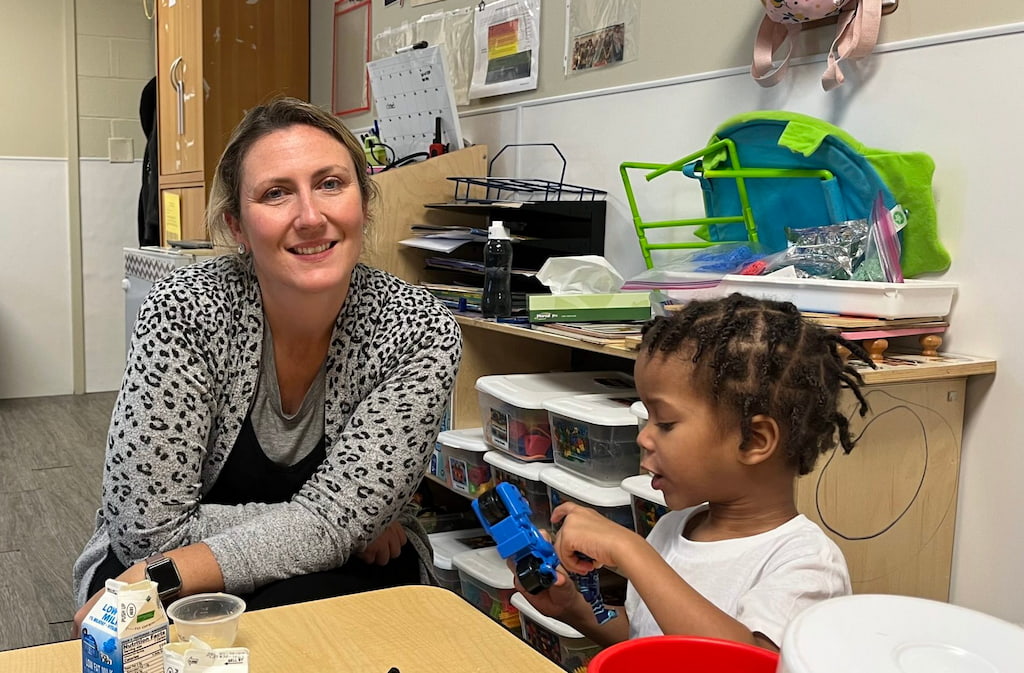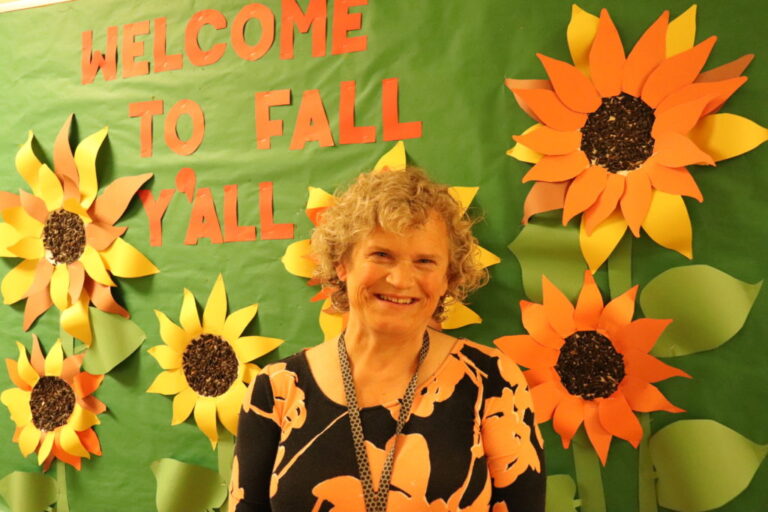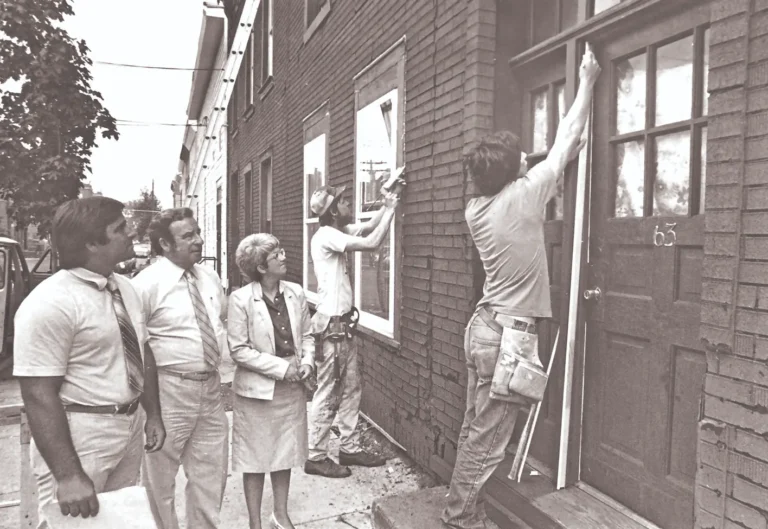Jocelyn has worked for CEO since 2014 in a variety of roles before settling into her current position as a Behavior Specialist. Her office is in the Community Resource Center (CRC) in Troy, but as a part of the Education Team, she spends a lot of time in all of the classrooms across the county observing and supporting.
The Behavior Specialist is an integral part of the Education Team, helping to support the classroom teachers through observation and hands-on support, as well as creating behavioral plans and coordinating with the rest of the Education Team.
7:30am
Jocelyn’s work schedule is 7:30am to 3pm Monday through Friday, which closely mirrors the Head Start classroom schedule across the agency.
Mondays and Fridays, Jocelyn starts her day in her CRC office so she can plan for the week and work on paperwork and other administrative duties. Tuesdays, Wednesdays, and Thursdays Jocelyn typically starts her day in one of CEO’s centers or school district-based classrooms. When she starts her day in the centers, she can talk with the managers, see how they need to be supported, meet with parents, and more.
Today is Monday and Jocelyn starts her day by clocking in at her office on the third floor of the CRC. She then checks in with Christina O’Brien, The Education Services Manager, to see if there are any schedule changes or classroom demands that she will need to rearrange things to accommodate.
8:00am
Jocelyn goes down to the CRC classrooms to visit and observe. Drop off starts at 8:00, so Jocelyn can say hello to the Center Manager and teachers and then is able to observe drop off, greet parents as they arrive, and help the kiddos transition to the the classrooms for the day.
Each of the classrooms have a tabletop activity set up for the children to transition to, which allows the children to have a little bit of time to come in and play to help get adjusted for the day. The school year just started, so everyone is getting to know each other and the classroom.
“We follow the Pyramid Model, so we are currently at the bottom of the pyramid and are seeing if the classroom setting can support the needs of the incoming students, and then we will build on that. Not a lot of these kids have had the exposure to structure and routine. Sometimes incoming children have a hard time with classroom expectations, being safe in the classroom, or working on appropriately expressing big feelings that they might have,” says Jocelyn. “Not every classroom has a need for me, but I do like to get to know every classroom. I like to get to know the teachers, so that they know there is support for them, and get to know the kiddos, so I can help them too if needed. I like to make sure everyone knows there is a resource here for them.”
9:00am
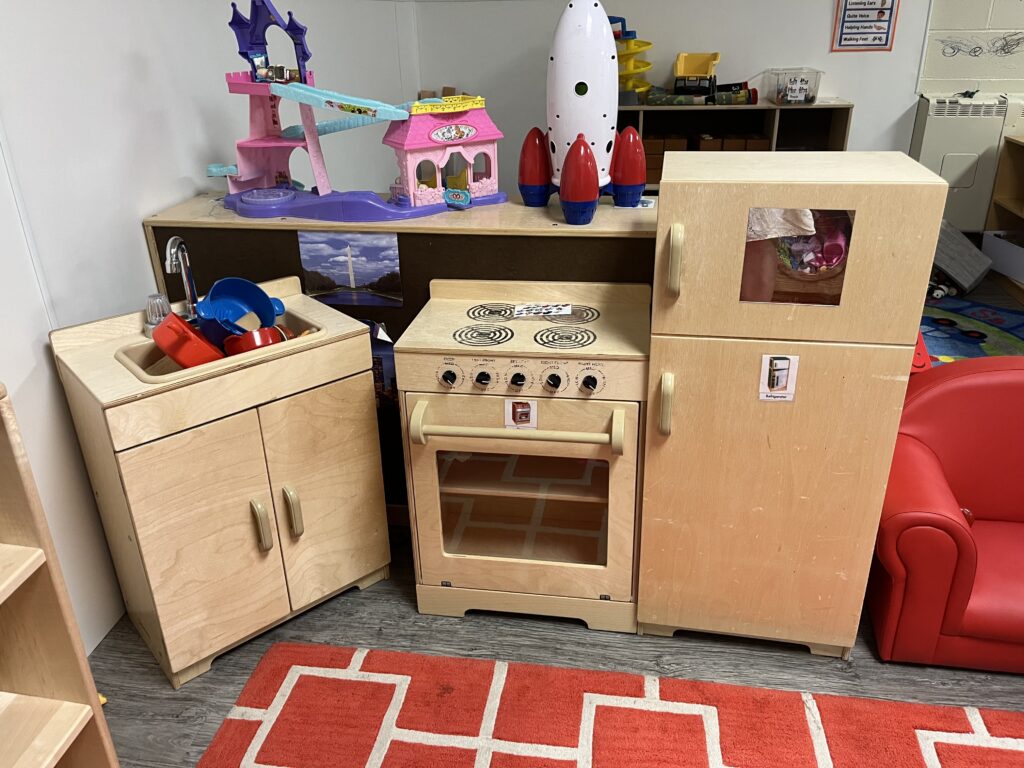
Just before breakfast, the kids wash their hands to get ready for breakfast. They have a quick circle time, then breakfast at 9:00 before they transition to center time.
During center time, each of the children can choose an activity or “center” to play in. Things like blocks, kitchen, reading nook, and more are all included. Center time is a great opportunity to observe because the lower numbers of children in each play area keeps things calmer and allow the kids to use skills like sharing and cooperative play which are important to observe. Teachers will sometimes do academic activities like name writing, sorting, or a social-emotional activity.
Since it’s still early in the school year, Jocelyn is just getting to know the classroom dynamics at this point. “We’ve noticed more and more kids coming in with needs over time,” says Jocelyn. With those needs, a lot of her role is to create a plan and help the teachers and parents navigate it as a team to make sure the child gets the support they need.
Typically, a Center Manager will reach out to Christina about a child that is having a hard time adjusting to some aspect of the classroom routine; it could be a first time in school issue, or there could be some developmental needs. A big part of Jocelyn’s role, combined with the rest of the Education Team’s input, is to determine what strategy or plan is going to work for each situation as not all strategies necessarily work for every child. For the best outcome, each child’s plan is individual to that child.
“I try to figure out what each kid is trying to communicate to us. I tend to meet with the teachers after the kids leave to see where they feel the need is for that child. Many needs are social emotional in nature, and it comes down to expressing feelings in constructive ways.”
The Education Team supports the classroom teachers in a variety of ways. If there is a concern about a child, they start by asking the teachers to document the behaviors in the classroom (BIR) that they are seeing. By noting what time of day and what’s happening before or after a negative behavior, the Education Team has some data to work with. The team is made up of Christina; Jen Baisley, Education Specialist; Jenna Graber, Education Specialist; Lori Tantakis, Director of Center Based Operations; and Jocelyn. In many instances, Jen and Jenna go into the classroom and help develop and Individual Plan for the child. If they feel it’s necessary, they will ask Jocelyn to go in and observe too, especially if the teachers are seeing more severe behaviors like nonverbal expression, climbing on shelves, hurting others– then it would go to Jocelyn for observation and the creation of a Behavior Plan.
11:00am

After center play, the classroom transitions to gross motor time. If the weather is good, the kids may go outside to the playground, or some centers have neighborhoods where a walk is an option. During bad weather, the teachers may take the kids to the gross motor room or stay in the classroom and do some dancing and movement.
Transitions throughout the day can be triggers for negative behaviors in some of the kids. That’s something that Jocelyn’s Behavior Plans address. She likes to give suggestions for how to manage those transitions successfully for the child. To create a Behavior Plan, Jocelyn relies on the data from the BIR, her observations in the classroom, and interviews with the teachers on the behaviors they are seeing. Jocelyn aims to pinpoint when dangerous or problematic behaviors are happening and come up with some strategies to deal with or prevent them. This might look like adding in more sensory activities into the child’s day or relying on heavy work to keep a child focused and give them purpose during a transition. A teacher might ask a kid to carry a bin of books to help them with a transition, or if a child is struggling with circle time, they might need to remain at a sensory table and listen to circle time even if they aren’t sitting with the rest of the class. “Each kid learns differently, mainly it’s about figuring out how each child learns best,” says Jocelyn.
Once that plan is written, Jocelyn meets with the Teaching Team. The Teaching Team collaborates with Jocelyn to get the plan in place, give it a few weeks, and adjust as needed. It usually takes about three weeks for a change to be noticeable.
Each year the number of kids Jocelyn helps varies. Right now, she is spending a lot of time helping classroom teachers put things together. Last year she was at School 2 almost all school year because of the needs of one classroom. There were five high needs kids, and lots of safety concerns in the classroom, social emotional regulation concerns, kids coming from homes with difficult situations, so building that connection and engaging them to help them feel safe at school helped.
11:30
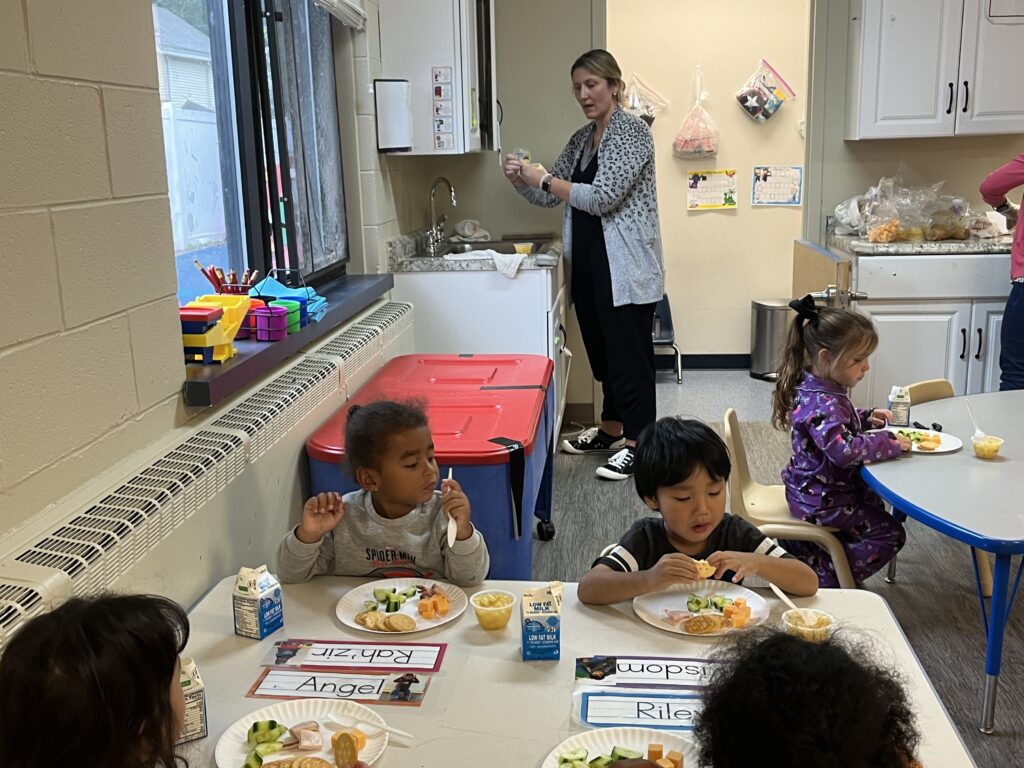
It’s time for the classroom to eat lunch. There is a lot for the teachers to do during that time, so the support and observation that Jocelyn offers is helpful.
In addition to lunch being a busy time, so is the beginning of the school year. The first 45 days there are a lot of deadlines they must meet because of Head Start standards:
- Initial Home Visits- for each of the kids within the first 45 days
- ESI/ASQs- screening testing for social emotional
“That’s a lot to keep track of in the first 45 days so I try to offer as much support as possible. Sometimes that’s discussing classroom changes, or accompanying a teacher on a home visit, or which challenging behaviors are the most critical when it feels like there is a lot going on in the classroom,” says Jocelyn.
Jocelyn supports this classroom all day long, so she has as much time to observe as possible. Tomorrow Jocelyn will be in Rensselaer, and later this week she will be in Hoosick Falls. Sometimes she will split her time between a few classrooms in a geographical area, but she likes to focus on one center or one part of the county every day.
Jocelyn primarily observes Head Start classrooms, but sometimes there are toddlers who are exhibiting needs too. The infant rooms Jocelyn treats as a chance to decompress between other classrooms.
12:00pm
After lunch it’s time for Free Play. The kids can pick a center area, or sometimes there are activities planned by the teacher.
Kids are still enrolling, and the school year is brand new, so this is another opportunity for Jocelyn to observe. On other days she might be helping to cover lunches, later in the school year, she might be doing one-on-one support of a child.
“ACES are high in the population we serve,” says Jocelyn. ACES, or Adverse Childhood Experiences, can contribute to many of the challenging behaviors that Jocelyn is pulled into the classroom to observe. Depending on the severity of a child’s needs, the Education Team can look at referrals to additional services such as:
Brightside Up Mental Health- Brightside Up will come out and work with the child and teachers in the school setting.
St. Catherine’s Mental Health– They can work with the child at home and at school and follow the child through their 18th year to help support the child and family.
The Education Services Manager, Christina, can also assist with special education referrals. The Education Team works hard to help make sure that every child and family gets the resources they need for success.
1pm
Jocelyn takes her lunch.
1:30pm
The Head Start day ends at 2:00 pm; parents begin arriving for pick-up and Jocelyn helps the kids and teachers during this transition time.
Jocelyn started off as a daycare teacher in an integrated classroom. That classroom collaborated with Capital District Beginnings, and after a few years Jocelyn then went to grad school. She worked for Beginnings while she was going back to school, and notes that she got a lot of knowledge and experience during that period. She says she has found a lot of inspiration working in special education.
2:00pm
After all the kids are gone, Jocelyn takes a few minutes to talk with the classroom teachers before going up to her office to record her notes. She also uses the last hour of the day to plan for tomorrow by touching base with Christina on needs across the agency. Although Jocelyn spends time in all the classrooms, she doesn’t have a set scheduled rotation around the centers, it’s determined entirely by where the need is. She emphasizes the importance of being flexible and the ability to go where she is needed, when she is needed.
Later in the school year, Jocelyn will be using this time to work on Individual Behavior Plans or to catch up on other administrative duties.
3:00pm
Jocelyn is done for the day and heads out to pick up her own children before her short commute to Cropseyville.
__
What is your favorite part of your job?
“I like it because it’s close to home, and the schedule works for our family. I like having a connection with all the teachers because I’ve been in their shoes and it’s relatable. I also have been that parent that has a child who has special needs and bringing that connection and understanding on both sides to my work is so important.
I just like to figure out kids. I like to figure out what’s going on in their brains. A lot of the time they just need love. They need to have that person that they can go to. I love their smiles; I just love the kids. And knowing that I’m making a change in their lives, I’m helping them set themselves up for success in the future. Who knows where they are going, whatever situations they may face; school can be their safe place.”

